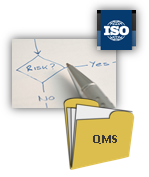Emerging digital technologies, increasing competition and changing customer demands put extra pressure on the businesses. In order to survive in the digital age, companies have to adapt to the changes and modify their operations through digital transformation.
While adapting new elements of digitization, the organization should bear in mind that that in order to achieve financial success, the investment into the digital transformation has to be combined with the clear vision of the process, careful coordination, engagement, and leadership.
For more digital transformation information, its benefits, potential pitfalls and ways to reach the competitive advantage, refer to
The Advantages of Digital Maturity
ISO 9001:2015
does not directly require the organization to undergo
digital transformation, though some of ISO 9001:2015 requirements are aligned with it.
MIT Sloan School of Management identifies
9 areas of digital transformation. Let’s review them with regards to the
ISO 9001:2015 clauses.
Customer focus
Top management shall demonstrate leadership and commitment with respect to customer focus by ensuring that:
a) customer and applicable statutory and regulatory requirements are determined, understood and consistently met;
b) the risks and opportunities that can affect conformity of products and services and the ability to enhance customer satisfaction are determined and addressed;
c) the focus on enhancing customer satisfaction is maintained
ISO 9001:2015 cl.5.1.2
Digitally transforming Customer Experience is the most visible and beneficial part of the Digital transformation.
1. Customer Understanding. It is a good practice to
- Leverage social media to understand the roots of customer dissatisfaction
- Build online communities to promote brands
- Use Analytic's capability to improve portfolios
2. Top-Line Growth
- Enhance sales with use of digital presentations and customer Analytic's data
3. Customer touch points. Create digital solutions that will leverage expert communities, resolve customer complaints quicker and overall improve customer service.
Process approach
This International Standard promotes the adoption of a process approach when developing, implementing
and improving the effectiveness of a quality management system, to enhance customer satisfaction by
meeting customer requirements.
ISO 9001:2014 Cl.0.3.1
Benefits from
Transforming Operational Processes are less visible in comparison to transforming the Customer experience and require more investment.
4. Process Digitization. Through automation of production processes, the Organization can improve product quality (avoid human error). The personnel, freed from the repetitive production jobs, can focus on RnD processes.
5. Worker Enablement
- Remote/virtual collaboration; ability to work from anywhere
- Creating organization wide knowledge banks (7.1.6 Organizational knowledge)
6. Performance Management
- The detailed information gathered from the transaction processing system allow management decision s to be made on the real data – versus the assumptions.
- Virtual collaboration enables better input into the processes, that will lead to the better risk and opportunities assessment
Digital transformation also
Transforms Business Models of the Organizations. They can benefit from pursuing new digital directions of business development or digitally modifying the existing ones.
7. Digitally Modified Businesses
- Outsourcing of customer service and post-delivery activity
8. New Digital Businesses will tackle customer needs that were overseen before.
9. Digital Globalization
- Global shared services promote efficiency and reduce risk.
Digital transformation provides opportunity for the Organization to
improve quality of product/services through the way individuals work and collaborate, the way business processes are executed and in the way a company understands and serves customers.
ISO 9001:2015 Documents and Templates collection.






